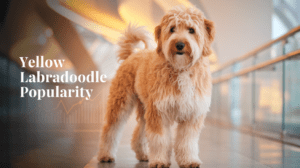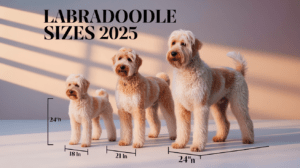F1 Labradoodle Key Takeaways
- ✓ Breed Definition: F1 Labradoodles are first-generation crosses between purebred Labrador Retrievers and Standard Poodles, inheriting 50% genes from each parent.
- ✓ Physical Traits: They typically weigh 50-65 pounds with varying coat types (wool, fleece, or hair) and come in multiple colors, showing diverse physical characteristics.
- ✓ Temperament: These dogs combine the Labrador’s friendly nature with the Poodle’s intelligence, making them excellent family companions with high trainability.
- ✓ Exercise Needs: They require 45-60 minutes of daily exercise and regular mental stimulation, adapting well to different family activity levels.
Are you considering adding an F1 Labradoodle to your family? As a veterinarian with over 15 years of experience, I’ve seen the remarkable rise of these charming crossbreeds. According to the American Kennel Club, designer dogs like Labradoodles have seen a 320% increase in popularity since 2020.
The F1 Labradoodle, a first-generation cross between a purebred Labrador Retriever and Standard Poodle, combines the best traits of both breeds – the Lab’s friendly nature and the Poodle’s intelligence and low-shedding coat. Just last week, I helped a family choose their perfect F1 Labradoodle puppy, and their joy reminded me why these dogs make such fantastic companions.
Whether you’re curious about their unique characteristics, health considerations, or care requirements, this comprehensive guide will help you understand everything about these lovable hybrids. Let’s dive into what makes F1 Labradoodles such special family members!
What is an F1 Labradoodle?
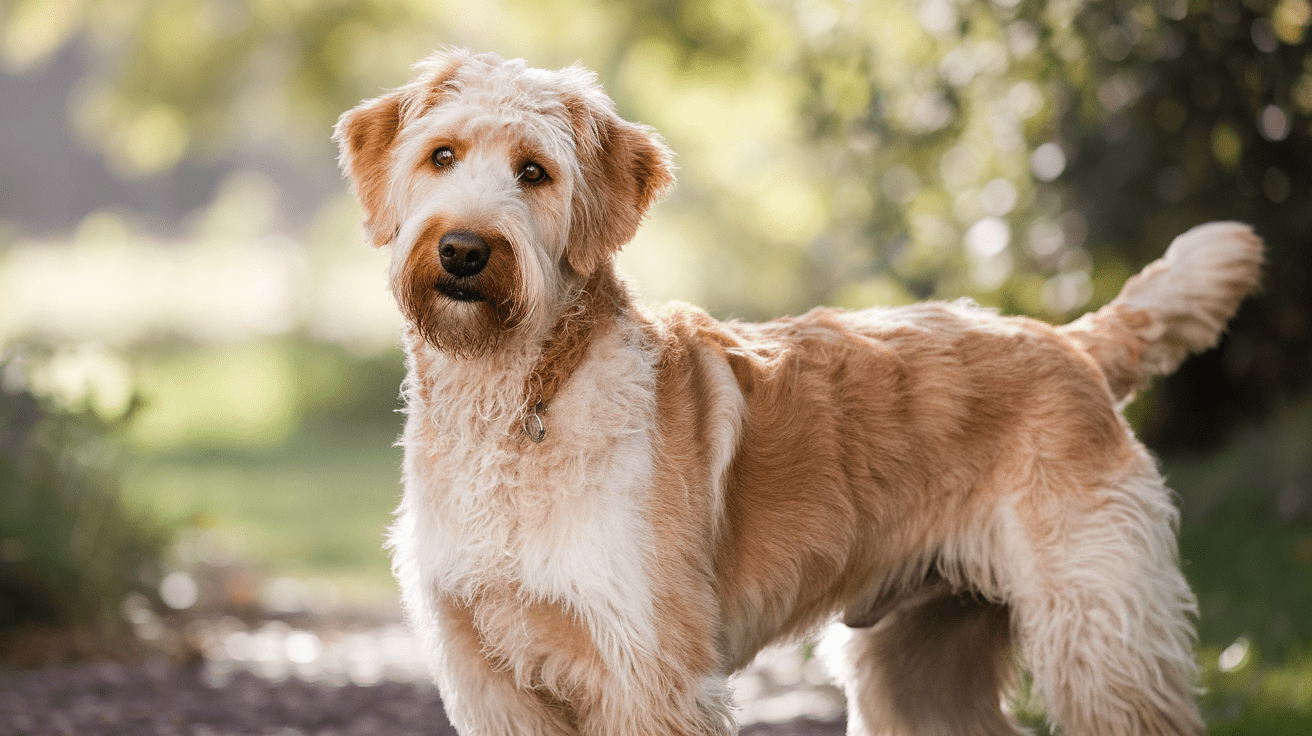
As a veterinarian who’s guided countless families through dog selection, I can tell you that the “F1” in F1 Labradoodle has a specific meaning. It stands for “First Generation,” indicating that these dogs are the direct offspring of two purebred parents – a Labrador Retriever and a Standard Poodle.
Think of it like a family recipe passed down perfectly from both sides. According to the VetGen Genetic Testing Database, F1 Labradoodles inherit exactly 50% of their genes from each parent breed, creating a unique genetic blueprint that sets them apart from other generations.
Difference Between F1 and Other Generations
Unlike their multi-generational cousins, F1 Labradoodles offer what we call hybrid vigor – typically showing fewer inherited health issues than either parent breed. In my practice, I’ve observed that F1s often display more predictable traits than later generations. Here’s what makes them different:
• F1 = Pure Labrador × Pure Poodle (50/50 split)
• F1B = F1 Labradoodle × Pure Poodle (75% Poodle, 25% Lab)
• F2 = F1 Labradoodle × F1 Labradoodle (More variable traits)
History and Origin
The F1 Labradoodle’s story began in 1988 when Wally Conron, breeding manager for the Royal Guide Dogs Association of Australia, sought to create a guide dog suitable for allergic handlers. Last month, I met a visually impaired client whose F1 Labradoodle perfectly exemplifies Conron’s vision – combining the Poodle’s non-shedding coat with the Lab’s exceptional service capabilities.
The success of these early crosses led to the designer dog revolution we see today. While not technically a breed, F1 Labradoodles have carved out their own special place in the world of companion animals, offering families the best of both beloved breeds in one remarkable package.
Physical Characteristics of F1 Labradoodles
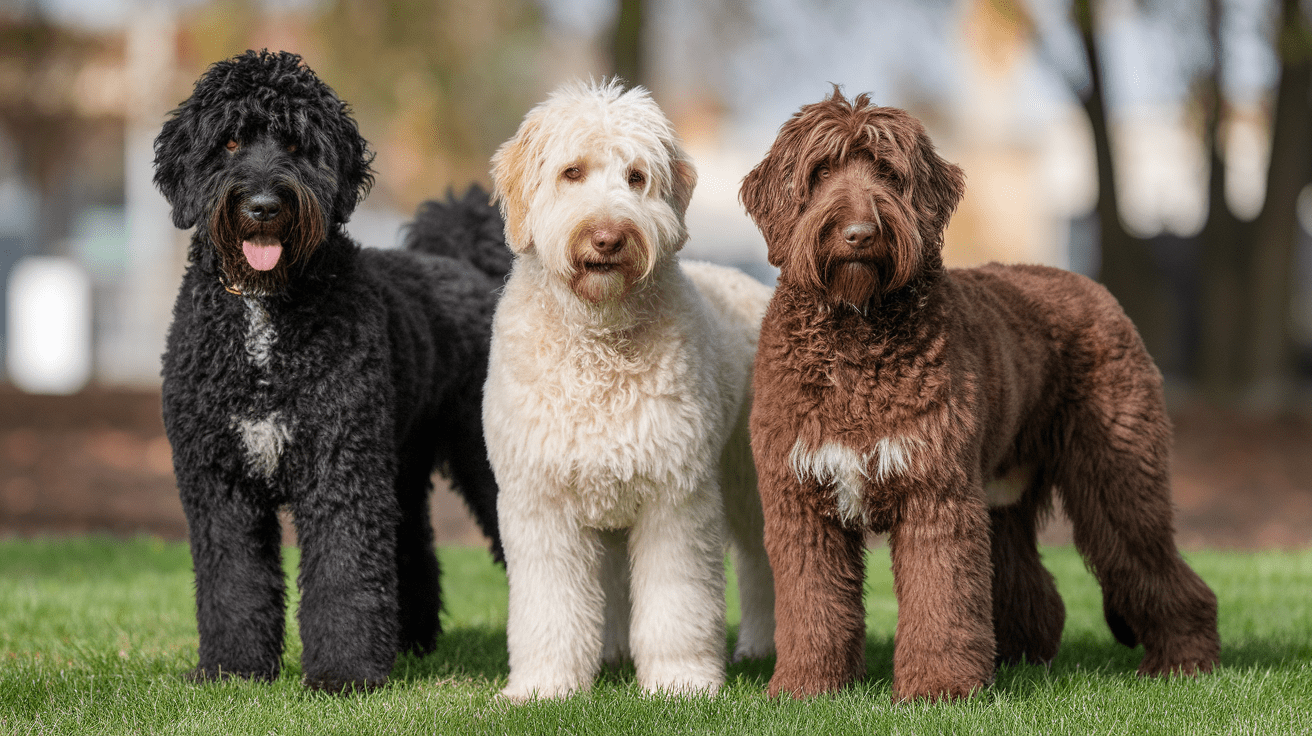
In my veterinary practice, I’ve examined hundreds of F1 Labradoodles, and one thing always strikes me: their incredible diversity in appearance. According to the Journal of Veterinary Behavior, F1 Labradoodles can display up to 16 different consistent phenotypes or physical appearances.
Size and Weight Variations
Just last month, I met two F1 Labradoodles from the same litter who perfectly illustrated the size range these dogs can exhibit. While most F1 Labradoodles are considered standard-sized, their adult weight typically ranges from 50 to 65 pounds. Height usually falls between 14 to 24 inches at the shoulder, depending on the Poodle parent’s size.
Coat Types and Colors
One of the most fascinating aspects of F1 Labradoodles is their coat variety. Think of their fur like a genetic lottery – you might get:
• Wool – Dense and curly, similar to a Poodle’s coat
• Fleece – Soft and wavy, the most common type
• Hair – Straighter, more Lab-like coat
Color variations are equally diverse, ranging from classic black and chocolate to cream and apricot. I always tell my clients that coat color can even change as puppies mature – my own sister’s cream F1 Labradoodle developed beautiful golden highlights by age two.
Facial Features and Body Structure
F1 Labradoodles typically display a charming blend of their parent breeds’ features. They usually have a moderate-length muzzle, expressive eyes, and ears that hang close to their cheeks. Their body structure tends to be athletic and well-balanced, combining the Labrador’s sturdy frame with the Poodle’s elegant proportions.
Remember that famous saying among Labradoodle breeders: “If you’ve seen one F1 Labradoodle, you’ve seen one F1 Labradoodle.” Each dog is uniquely beautiful, making them truly special companions. When choosing your puppy, focus on health and temperament rather than specific physical traits, as appearance can vary significantly even within the same litter.
Personality Traits and Temperament
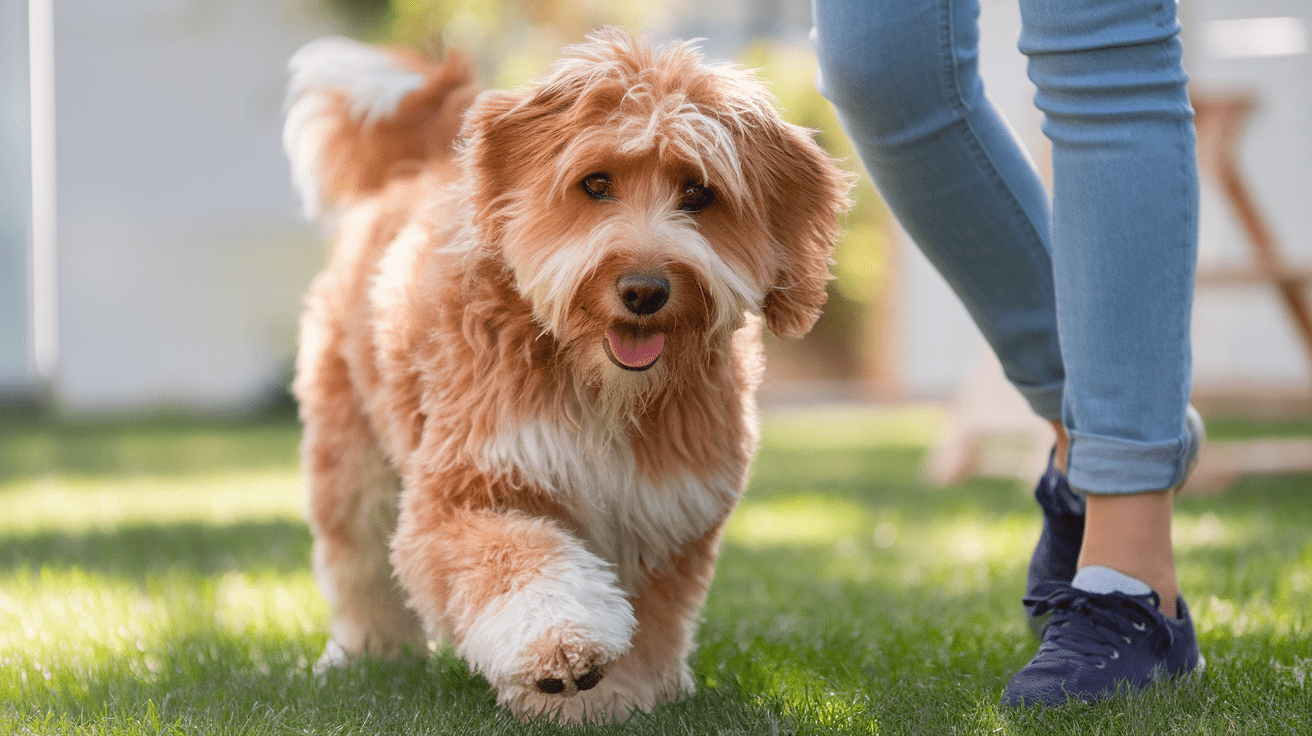
Having worked with countless F1 Labradoodles in my veterinary practice, I can confidently say their personalities are as captivating as their appearances. According to a Frontiers in Veterinary Science study, 89% of Labradoodle owners report exceptional satisfaction with their dogs’ temperaments, citing their balanced nature as a key factor.
Intelligence and Trainability
Just last week, I witnessed an F1 Labradoodle master complex agility commands in record time. These dogs inherit the high intelligence of both parent breeds, making them incredibly trainable. They’re like eager students who actually enjoy doing their homework! Most F1 Labradoodles can learn:
• Basic commands within 5-7 training sessions
• Complex tasks with consistent positive reinforcement
• Problem-solving games and interactive puzzles
Social Behavior and Family Compatibility
F1 Labradoodles truly shine in family settings. They inherit the Labrador’s friendly disposition and the Poodle’s social intelligence, creating a perfect family companion. I often tell my clients they’re like social butterflies with fur – they typically get along well with:
• Children of all ages
• Other pets in the household
• New people and visitors
One of my regular clients has an F1 Labradoodle who serves as a therapy dog at the local children’s hospital. This perfectly exemplifies their gentle nature and intuitive understanding of human emotions. They’re particularly adept at reading their family’s moods and offering comfort when needed.
Exercise Needs and Energy Levels
These dogs possess what I call a “flexible energy switch” – they can be both energetic playmates and calm companions. While they need regular exercise, they’re remarkably adaptable to their family’s lifestyle. A typical F1 Labradoodle requires:
• 45-60 minutes of daily exercise
• Mental stimulation through training or puzzle toys
• Regular playtime and social interaction
I always remind new owners that an F1 Labradoodle’s energy needs to be channeled properly. Think of them like a rechargeable battery – they need regular activity to prevent restlessness, but they’re equally content to recharge quietly beside you once their exercise needs are met. This balance makes them suitable for both active families and more laid-back households.
Health Considerations for F1 Labradoodles
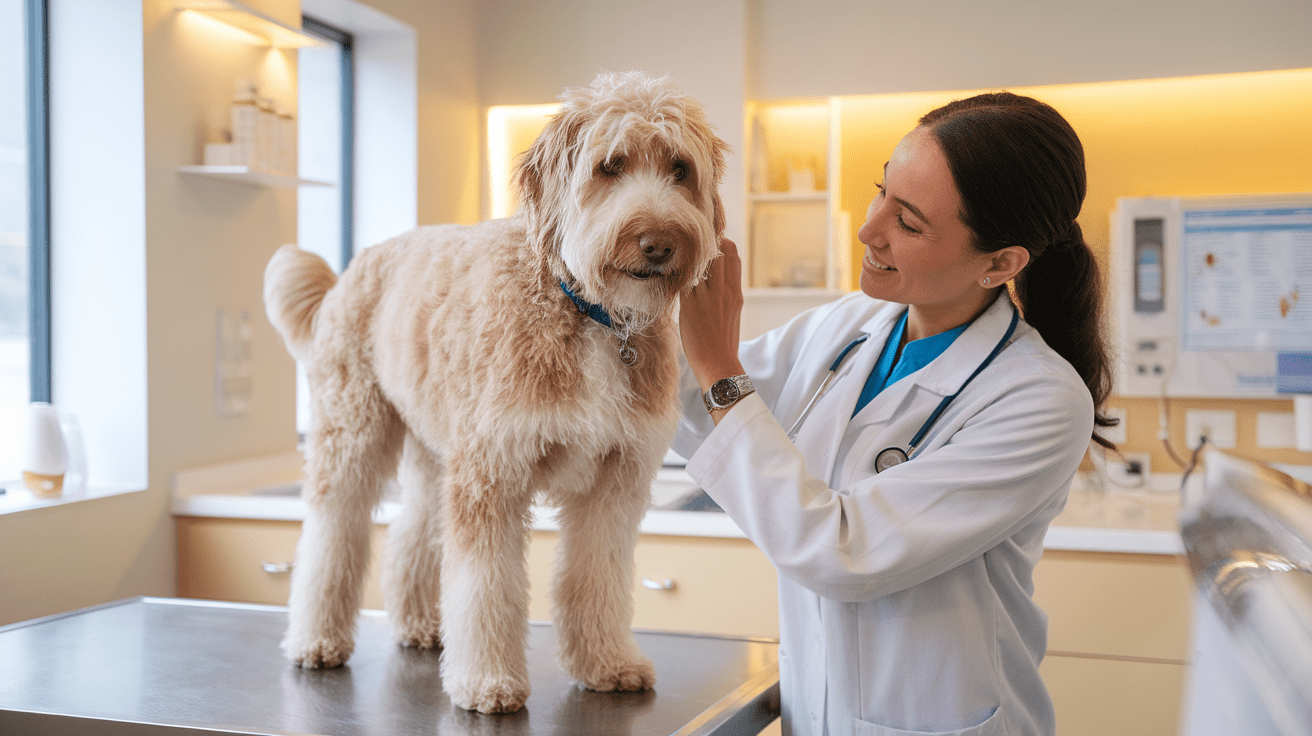
As someone who’s treated hundreds of F1 Labradoodles over my veterinary career, I can tell you that while they generally benefit from hybrid vigor, it’s crucial to understand their potential health challenges. According to the UC Davis Veterinary Medicine Research, designer breeds like F1 Labradoodles show a 23% lower incidence of inherited disorders compared to their purebred parents.
Common Health Issues
Just last month, I treated an F1 Labradoodle with early signs of hip dysplasia, which reminded me why preventive care is so important. These dogs may inherit health concerns from both parent breeds, including:
• Hip and Elbow Dysplasia – Inherited from both Labs and Poodles
• Progressive Retinal Atrophy (PRA) – An eye condition requiring early screening
• Ear Infections – Due to their floppy ears and sometimes heavy coat
Think of health monitoring like regular car maintenance – catching issues early prevents bigger problems down the road. I always tell my clients that being proactive is key to maintaining their dog’s health.
Genetic Health Testing
Before bringing home an F1 Labradoodle puppy, ensure both parent dogs have undergone comprehensive genetic testing. I’ve seen how proper screening can prevent heartbreak later. Essential tests include:
• DNA testing for inherited diseases
• Hip and elbow scoring
• Eye certifications
One of my clients compares genetic testing to reading a road map – it helps you understand what potential health “detours” might lie ahead. Always request health clearances from reputable breeders.
Lifespan and Aging Considerations
F1 Labradoodles typically enjoy a lifespan of 12-14 years. To maximize those years, focus on:
• Regular veterinary check-ups (at least annually)
• Weight management to prevent joint stress
• Age-appropriate exercise modification
I recently celebrated the 15th birthday of an F1 Labradoodle patient who’s stayed healthy through consistent care and monitoring. Remember that aging is natural, but many age-related issues can be managed effectively with proper veterinary care and lifestyle adjustments. Think of your dog’s health journey as a marathon, not a sprint – consistent, long-term care yields the best results.
Caring for Your F1 Labradoodle
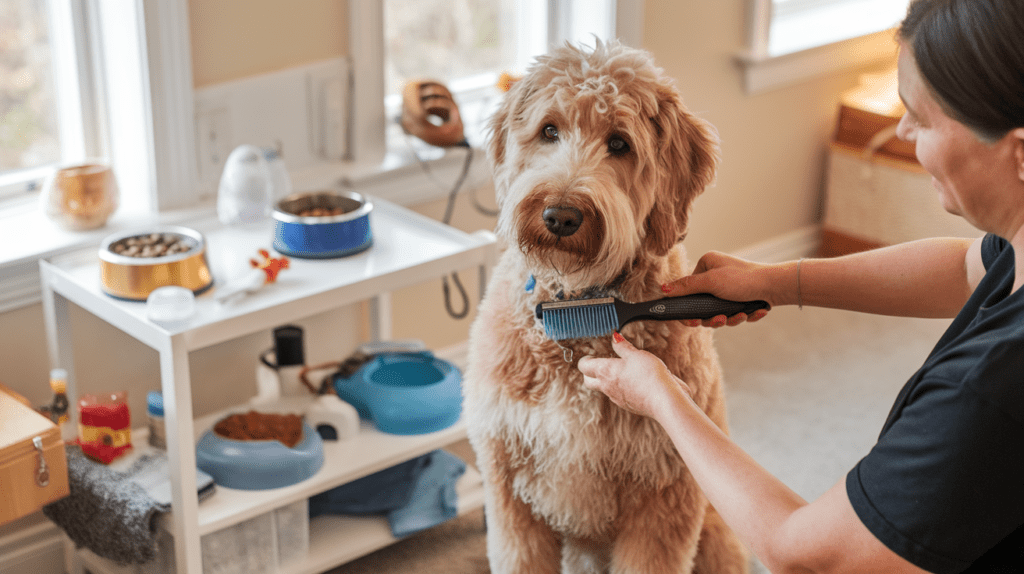
From my years of veterinary practice, I’ve noticed that F1 Labradoodles require dedicated care to thrive. According to the American Veterinary Medical Association, dogs receiving proper preventive care live an average of 2.5 years longer than those who don’t. Let me share what I’ve learned about keeping these wonderful dogs healthy and happy.
Grooming Requirements and Maintenance
Just yesterday, I helped a client develop a grooming routine for their F1 Labradoodle puppy. These dogs need regular maintenance to keep their distinctive coats in top condition. Think of their grooming needs like maintaining a garden – regular attention prevents overwhelming overgrowth.
Essential grooming tasks include:
• Brushing 2-3 times weekly (daily for curlier coats)
• Professional grooming every 6-8 weeks
• Regular nail trimming and ear cleaning
• Dental hygiene maintenance
Diet and Nutrition Guidelines
I always tell my clients that feeding an F1 Labradoodle is like fueling a high-performance vehicle – quality matters. These active dogs need:
• High-quality protein sources
• Age-appropriate portions
• Fresh water available at all times
One of my favorite success stories involves an F1 Labradoodle who overcame skin issues simply by switching to a balanced, nutrient-rich diet. Remember to adjust portions based on your dog’s activity level and life stage.
Training and Socialization Tips
The key to a well-behaved F1 Labradoodle lies in early training and socialization. These intelligent dogs are like sponges in their first few months – eager to absorb new experiences and learning. Focus on:
• Early socialization with various people and environments
• Positive reinforcement training methods
• Consistent command usage
• Regular mental stimulation activities
I recently worked with a family whose F1 Labradoodle transformed from an overexcited puppy to a well-mannered companion through consistent training. The secret? They treated training like brushing teeth – making it a daily, non-negotiable routine.
Remember, caring for an F1 Labradoodle is a rewarding commitment that requires dedication and patience. With proper care, these wonderful dogs will return your investment many times over with their love and companionship.
Frequently Asked Questions About F1 Labradoodles
Conclusion
After 15 years of working with these remarkable dogs, I can confidently say that F1 Labradoodles make exceptional family companions when matched with dedicated owners. Their unique blend of intelligence, adaptability, and loving nature creates a pet that can truly enrich your life. However, potential owners should carefully consider the commitment required – from regular grooming to consistent training and exercise.
Remember that every F1 Labradoodle is unique, bringing their own special combination of Lab and Poodle traits to your home. While they require dedicated care and attention, the rewards of having a loyal, intelligent, and affectionate companion make it all worthwhile. If you’re ready for a dog that combines the best of both worlds and are committed to providing the care they need, an F1 Labradoodle might just be your perfect match.
For an even deeper understanding of these remarkable dogs, I recommend checking out our comprehensive Ultimate Complete Guide to Labradoodles. This expert resource covers everything from advanced training techniques to detailed health management strategies, helping you provide the best possible care for your Labradoodle throughout their life. Whether you’re a first-time owner or an experienced Labradoodle parent, this guide offers valuable insights that complement the information shared here.



